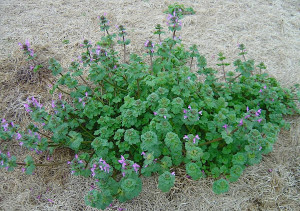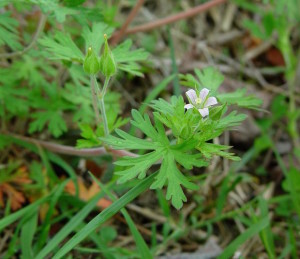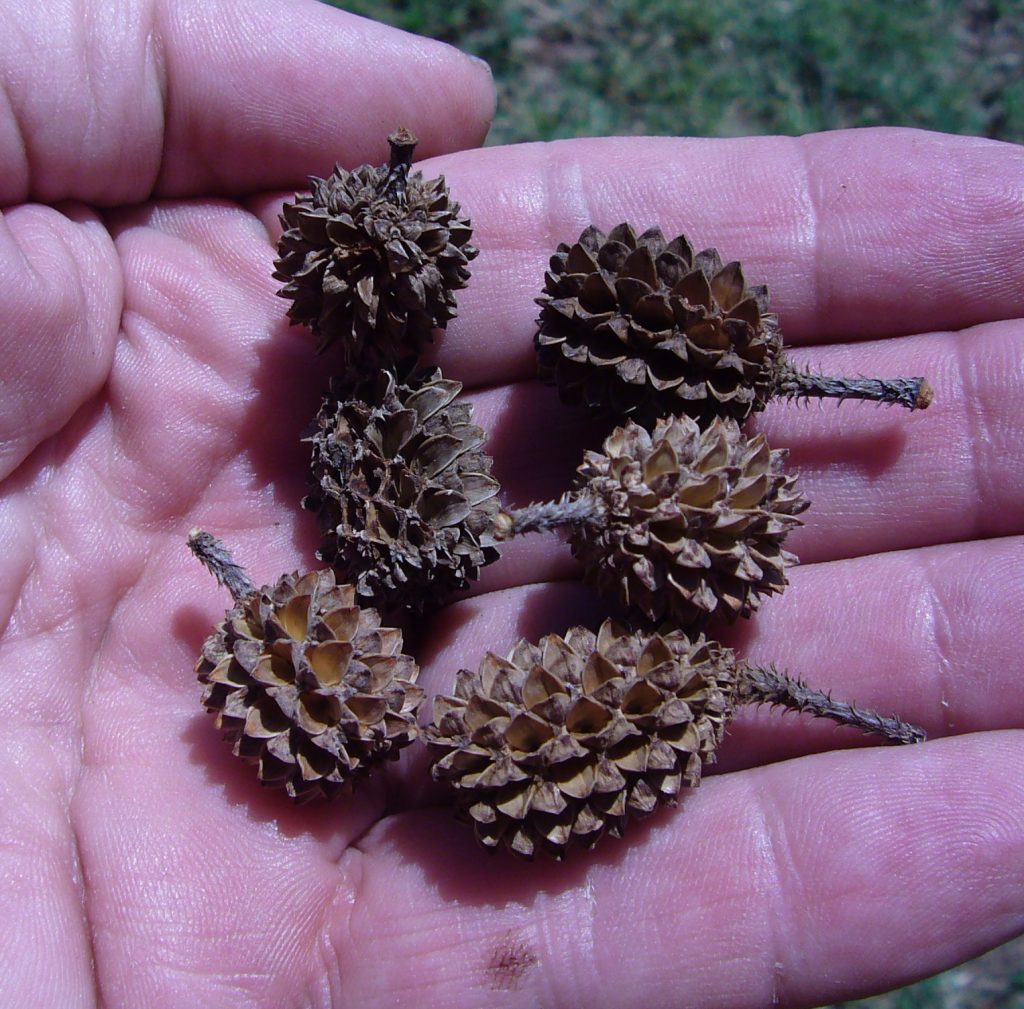
Cones from the Australian Pine minus seeds. Photo by Green Deane
I recently uploaded a new video about the Australian Pine. I see an attractive stand of them regularly in Port Charlotte (on Bayshore near Ganyard.) It’s a much maligned tree that suffers under the rubricks of “invasive weed.” That means some official decided it is out of control, not good for the environment, and harmful to the local ecosystem. Yet, in other countries it is intentionally planted. The tree has edible parts. While there can indeed be ecological reasons to trash a plant that designation almost always carries with it a load of attitude as well… kind of like botanical bullying.
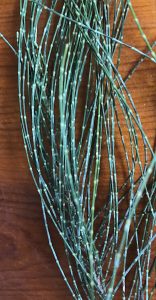
The Australian Pine has branchlets not needles. Photo by Green Deane
The Australian Pine is not a pine and is more closely related to the oaks. In fact it is often called the “she oak.” It’s a prime source of firewood (and can be burned immediately after cutting.) It is also used for smoking meat and fish as are the “needles” after soaking them salt water. And those whispy rhapidophyllum are not needles. They are branchlets. (Rhapidophyllum, from the Greek, is the botanical name for needle-leaf whereas in the animal world the same shape is hystrix also from the Greek ὕστριξ meaning porcupine.) And as one might guess the Needle Palm is Rhapidophyllum hystrix, a bit of drunk botanical overkill there. It’s a cold-hardly palm that hurts like hell and will grow as far north as Long Island and Seattle.
In Florida Australian Pines are seen as far north as Haul Over Canal, just north of the space center where they hold the dirt banks of the canal in place. And they are also in the center of the state in Deland, home of Stetson College. The species barely fits into the edible realm. It’s sap is drinkable, the branchlets edible as are the cones but better are the roasted seeds. In the video I highlight their nutritional content. You can watch it here.
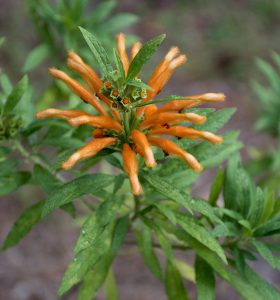
A young Leonotis leonurus blossom. Photo by Green Deane
There’s an innocent-looking ornamental plant in local parks which in some European countries the possession of which can get you 30 years in prison: Wild Dagga, or, Leonotis leonurus. As a student of Greek I always have an issue with the name because “Leonotis” means “Lion’s Ear” while “leonurus” is mangled Greek and “new” Latin for “Lion’s Tail.” So it’s name is Lion’s Ear Lion’s Tail…. more drunk botanical overkill. They took it all from the historical King of Sparta, λέωνῐ́δᾱς, or Leonida, which means “son of a lion.” A second species found locally — and more often — is Leonotis nepetifolia (catnip leaf.) The plants look similar except “lion tail” has skinny leaves like marijuana, and the “catnip leaf’ has somewhat large diamond-shaped leaves like catnip. The blossoms and over all growth pattern is similar for both. From tropical South Africa and India Lion’s Tail is used … recreationally… where as Catnip Leaf is used medicinally. Both have leonurine, Lion’s Tail apparently more than Catnip Leaf. Water extraction — tea — is the common method. A 2015 study says Leonotis leonurus seems to be mildly pschoactive. “Research has proven the psychoactive effects of the crude extract of L. leonurus, but confirmation of the presence of psychoactive compounds, as well as isolation and characterization, is still required.” Sounds like a pitch for more research money. Others report both species contain marrubiin which is an analgesic and probably why they have been used in traditional medicine. Bees and humming birds also like the species. I will be doing a video on them. A relevant pubmed article can be read at: https://pubmed.ncbi.nlm.nih.gov/29016795/
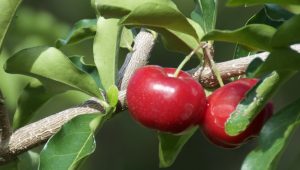
The city of Winter Park has added an edible to their downtown park. Photo by Green Deane
My annual Urban Crawl is coming up, my twelfth, on Friday, December 17th. It’s a free class. We meet in front of Panera’s at 10 a.m. in Winter Park. We wander south to the college, stop at Starbucks to drink & drain, go east to the public library area, then back to Panera’s around noon. There is a free parking garage behind (west) of Paneras if you go to the upper floors. If you park on the city streets you chance a ticket as the class is longer than parking hours allow. A year ago in their downtown park they removed a Limequat leaving the space empty. I have no idea why the tree had to go in that it was regularly fruiting and while not rare a novelty. It was replaced by a Acerola Cherry also called Barbados Cherry. This little tree’s claim to fame is a huge amount of acorbic acid which is natural vitamin C. It often has fruit on the ground.
The first is Henbit. It’s in the mint family but does not smell or taste minty. It does, however, have a square stem and the blossoms resembles mints. In northern climates it is one of the first green plants to pop up after the snow goes (it and chickweed.) Locally it likes our cooler months of the year. It was esteemed by the natives because among all the annual greens it is not spicy but rather mild if not on the sweet side. What can be confusing about it is that the leave shape and stem length is different from young to old leaves. But they all have a scalloped shape. It also has a similar looking relative that is also edible called Dead Nettle. You can read about Henbit here.
Also found in lawns this time of year are wild geraniums, usually Cranesbill or Stork’s Bill. (Why one is one word and the other two-words possessive I do not know.) Botanically they are Geranium carolinianum and Erodium circutarium. Neither is great foraging. In fact both are more medicinal than edible but they seem to get mention in a variety of foraging books. The problem is they are extremely bitter. You might be able to toss a little bit of both in a salad but that’s about the extent of it. If you have what you think is a Cranesbill or a Stork’s Bill but it has more of a bottle brush blossom than five petals you might have the non-edible Fumaria. It comes up this time of year and from a distance the leaves can remind one of the wild geraniums. To read more about them go here.
Foraging Classes: This weekend before Christmas we visit Red Bug Slough, always a ncie walk in Sarasota, and then to a familiar standby in east Orlando, Blanchard Park. Please note something different on January second and further down in the newsletter my Urban Crawl next week.
Saturday December 11th, Red Bug Slough Preserve, 5200 Beneva Road, Sarasota, FL, 34233. 9 a.m. to noon. Meet by the playground.
Sunday December 12th, Blanchard Park, 10501 Jay Blanchard Trail, Orlando, FL 32817. 9 a.m to noon, meet at the pavilion next to the tennis courts.
Saturday December 18th, Bayshore Live Oak Park, Bayshore Drive. Port Charlotte. 9 a.m. to noon. This class will not meet and will be rescheduled.
Sunday December 19th, Colby-Alderman Park: 1099 Massachusetts Street, Cassadaga. Fla. 32706. 9 a.m. to noon. Meet at the bathrooms.
Sunday December 26th, Mead Garden: 1500 S. Denning Dr., Winter Park, FL 32789. 9 a.m. to noon. Meet at the bathrooms. The park entrance is on South Denning. Some GPS directions get it wrong.
Sunday January 2nd, as Monty Python used to say, “and now for something different.” Let’s meet at 10 a.m. (at the bathrooms) and wander around Lori Wilson Park, Cocoa Beach, for a couple of hours. No fee. I did a short private class there a couple of years ago. Not sure it is extensive enough for a regular class. If the weather’s pleasant it will be a nice way to start the new year. 1500 N. Atlantic Avenue, Cocoa Beach Fl 32931.
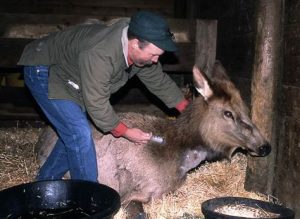
Walt Cook, a Wyoming state veterinarian, takes care of one 300 stricken elk, all of which quickly died after eating a lichen, Parmelia molliuscula.
I am constantly meeting people who want to reduce the entire realm of foraging down to one sentence: “If the animals can eat it you can eat it.” That advice can kill you and or make you very ill. Birds can eat arsenic, squirrels strychnine, poison ivy is high-protein deer food. Conversely day lilies kill cats and avocados crash canaries. Three hundred elk were killed in Wyoming eating native lichen. Animals don’t have a great sense of what is not edible. Hunger can override what defenses they have. There’a quite a list of false advice for humans. You hear “all black berries are edible.” Wrong. “Most red berries are edible,” Wrong. The best you can do with berries is that almost all white berries are toxic. Not all but almost all, or enough of them to leave white berries alone. In the satirical novella Animal Farm, by George Orwell, the final rule is “all animals are equal but some are more equal than others.” That might be said about eating plants. Goats can eat almost anything. They are the garbage scows of the world, putting pigs to shame. However avocados will kill goats, but not us. In fact Avocados are toxic to most creatures. That said, as humans go we are fairly limited compared to animals, tolerance-wise. That’s another reason to know your plants and use the I.T.E.M. system, Identification, Time of Year, Environment, Method of Preparation. Unlike domesticated plants wild plants still have their defense mechanisms. (Bitter is often a warning sign.) I had a fellow email me from a Mediterranean country. He said his foraging method was if it tasted good he ate it, if it tasted bad he didn’t eat it. He asked me what I thought of that. I replied I hoped he had good life insurance.

Green Deane videos are now available on a USB.
My nine-DVD set of 135 videos has been phased out and replaced by a 150-video USB. The USB videos are the same videos I have on You Tube. Some people like to have their own copy. The USB videos have to be copied to your computer to play. They’re a nice Christmas gift sent by First Class Mail. If you want to order the USB go to the DVD/USB order button on the top right of this page or click here. That will take you to an order form. I’d like to thank all of you who ordered the DVD set over the years which required me to burn over 5,000 DVDs individually.

Green Deane Forum
Want to identify a plant? Perhaps you’re looking for a foraging reference? You might have a UFO, an Unidentified Flowering Object, you want identified. On the Green Deane Forum we — including Green Deane and others from around the world — chat about foraging all year. And it’s not just about warm-weather plants or just North American flora. Many nations share common weeds so there’s a lot to talk about, such as the one to the left. There’s also more than weeds. The reference section has information for foraging around the world. There are also articles on food preservation, and forgotten skills from making bows to fermenting food. Recent topics include: California Wild Mushroom Parties, A Good Reason To Eat Wild Garlic, Black Walnuts and Amaranth, Sea Salt and Plastic, Wild Mustard? Heavy Metals. Oriental Persimmons. What is it? Pine Cough Drops and Needles, Skullcap, Malodorous Plant? Another NJ Tree, Maypop? Roadside Plant, Unknown in Sudan, Please Help Identify, and Preserving Prickly Pear Bounty. You can join the forum by clicking on the button on the upper right hand side of this page.
This is my weekly newsletter #485. If you want to subscribe to this free newsletter you can find the sign-up form in the menu at the top of the page.
And on this date 80 years ago I had an uncle in the Navy at Pearl Harbor. He survived the attach and the war.
To donate to the Green Deane Newsletter click here.

